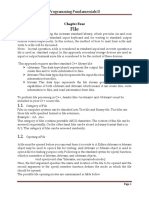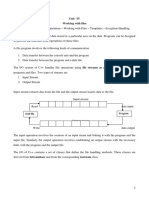0% found this document useful (0 votes)
11 views2 pagesFile Pointer
The document explains the functions seekg() and seekp() for moving the get and put pointers in a file, respectively. It also details the tellg() and tellp() functions for retrieving the current positions of these pointers. Additionally, it provides examples of how to use seekg() to navigate within a file using absolute and relative positions.
Uploaded by
Sadman HossainCopyright
© © All Rights Reserved
We take content rights seriously. If you suspect this is your content, claim it here.
Available Formats
Download as PDF, TXT or read online on Scribd
0% found this document useful (0 votes)
11 views2 pagesFile Pointer
The document explains the functions seekg() and seekp() for moving the get and put pointers in a file, respectively. It also details the tellg() and tellp() functions for retrieving the current positions of these pointers. Additionally, it provides examples of how to use seekg() to navigate within a file using absolute and relative positions.
Uploaded by
Sadman HossainCopyright
© © All Rights Reserved
We take content rights seriously. If you suspect this is your content, claim it here.
Available Formats
Download as PDF, TXT or read online on Scribd
/ 2































































